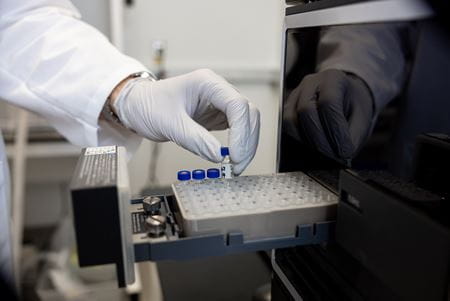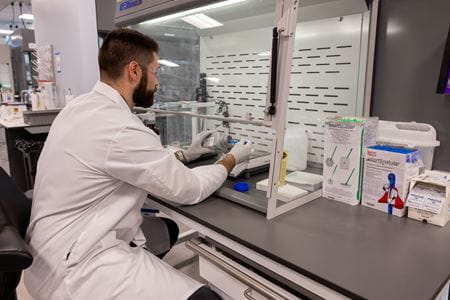INDIANAPOLIS — A team of researchers from an Indiana University School of Medicine-led drug discovery program aims to develop a new treatment for neurodegeneration by targeting an immune cell-specific gene associated with Alzheimer's disease.
The study focuses on better understanding the role of — and potentially influencing — a gene associated with microglia, the brain’s primary immune cell. Microglia act as the first line of defense against viruses, neurotoxins and damaged neurons in the brain and has been found to clear amyloid plaques — a hallmark of Alzheimer’s disease that contributes to its progression.
Timothy Richardson, PhD, senior research professor of medicine, said the gene, INPP5D, encodes the protein SHIP1 and has been identified as a risk gene for Alzheimer’s disease.
"Our research team aims to optimize small molecules into drug candidates that block SHIP1, a protein that acts like a brake on microglia function," Richardson said. "We believe inhibitors will make these immune cells more effective at cleaning up harmful proteins, like taking the foot off the brake of a snowplow and stepping on the gas to clear snow from the road more quickly."
Richardson is also a co-principal investigator of the TREAT-AD — Target Enablement to Accelerate Therapy Development for Alzheimer’s disease — drug discovery center. TREAT-AD researchers evaluated hundreds of potential drug targets and narrowed down the list to focus on a portfolio five novel targets, with INPP5D/SHIP1 leading the way.

The researchers will study a gene associated with the brain's primary immune cells, microglia, which have been found to clear amyloid plaques — a hallmark characteristic of Alzheimer’s disease. | Photo by Liz Kaye, Indiana University
The National Institute on Aging, part of the National Institutes of Health, awarded the IU School of Medicine a five-year, $11.3 million grant in December 2024 to further study the gene.
Richardson leads the grant with co-principal investigators Adrian Oblak, PhD, associate professor of radiology and imaging sciences; Jeff Dage, PhD, senior research professor of neurology; Bruce Lamb, PhD, executive director of the Stark Neurosciences Research Institute, a Distinguished Professor of Medicine and the Roberts Family Professor of Alzheimer's Disease Research; and Alan Palkowitz, PhD, senior research professor of medicine — all of the IU School of Medicine — and Andrew Mesecar, PhD, the Walther Professor in Cancer Structural Biology at Purdue University.
Opportunity for next-generation drugs
Alzheimer's disease, which impacts more than 7 million Americans, is a neurodegenerative condition that causes memory loss and cognitive decline. It's commonly associated with the buildup of amyloid plaques and tangles of another protein called tau in the brain, as well as neuroinflammation, which involves the activation and function of microglia.
Over the past few years, the Food and Drug Administration has granted approval to two disease-modifying antibody drugs for Alzheimer's disease — lecanemab in 2023 and donanemab in 2024 — that have been shown to reduce amyloid plaques in the brain. The IU School of Medicine has been at the forefront of clinical research into both drugs.
With these antibodies as the new baseline for clinical management of select patients in early stages of Alzheimer's disease, Richardson said there's a new opportunity to study the potential efficacy and safety of next-generation drugs and how they could be used individually or perhaps in combination with treatments like lecanemab or donanemab.
"There is still a need for more effective, safer and less expensive treatments," Richardson said. "We are looking forward to a future when Alzheimer's disease is a preventable and treatable disease like diabetes and cardiovascular diseases."
Oblak, who is also a principal investigator of the IU School of Medicine-led Model Organism Development and Evaluation for Late-Onset Alzheimer's Disease (MODEL-AD) consortium, a partnership between four institutions developing the next generation of animal models for Alzheimer's disease, spearheaded research to uncover molecular mechanisms of INPP5D.
"Our lab realized that TREAT-AD's infrastructure and expertise would allow us to delve deeper into the druggable aspects of INPP5D," Oblak said. "We saw this partnership as a way to access cutting-edge drug discovery platforms, advanced molecular tools and the collective expertise of a collaborative network — all of which are essential for translating basic research into tangible therapeutic strategies for Alzheimer's disease."

Ryan Imhoff, a postdoctoral fellow at the IU School of Medicine, works in a lab at the Indiana Biosciences Research Institute, a key partner in the TREAT-AD drug discovery center. | Photo by Liz Kaye, Indiana University
The grant aims to help researchers develop better inhibitors of SHIP1/INPP5D by studying and optimizing compounds that block the protein and allow microglia to work better in the brain to clear plaques. The team will test these inhibitors in Alzheimer’s disease mouse models, seeing how they inhibit SHIP1, how they activate microglia, and whether they slow cognitive decline and improve brain health.
Ultimately, Richardson said the team will focus on developing the most promising compounds for clinical studies in humans. They will also identify biomarkers measurable using blood and cerebral spinal fluid that can track a potential drug’s activity and effectiveness in clinical trials.
Protecting the brain
Richardson and Oblak also received a five-year, $4 million grant in June from the National Institute on Aging that will explore an alternative approach to inhibiting SHIP1. Their goal is to test whether reducing the expression of INPP5D in microglia can also help protect the brain.
Working with their colleague, Travis Johnson, PhD, assistant professor of biostatistics and health data science, they found that certain forms of INPP5D are differentially expressed in Alzheimer’s patients compared to cognitively normal, age-matched control patients.
Richardson’s lab is designing small interfering RNAs (siRNAs) that harness the cell’s natural machinery for regulating gene expression. The siRNAs will be tested by Oblak using animal models of Alzheimer’s disease to investigate whether microglia can reduce amyloid plaques and improve brain health. Results from this work will be compared with the small-molecule research.
Oblak said comprehensive programs in Alzheimer’s disease research at IU School of Medicine, like MODEL-AD and TREAT-AD, have been transformative for the school's researchers working in the field of neurodegeneration. The research environment provides investigators access to an unparalleled range of resources and multidisciplinary expertise not found at most institutions, she said.
"More importantly, they foster a collaborative spirit that bridges diverse disciplines. This environment not only accelerates the pace of discovery but also enhances the robustness and reproducibility of the research," Oblak added. "This synergy is invaluable, as it allows us to address complex research questions with the confidence that our discoveries can be efficiently channeled toward improving patient outcomes."
About Indiana University School of Medicine
The IU School of Medicine is the largest medical school in the U.S. and is annually ranked among the top medical schools in the nation by U.S. News & World Report. The school offers high-quality medical education, access to leading medical research and rich campus life in nine Indiana cities, including rural and urban locations consistently recognized for livability. According to the Blue Ridge Institute for Medical Research, the IU School of Medicine ranks No. 13 in 2023 National Institutes of Health funding among all public medical schools in the country.
Writer: Ben Middelkamp, bmiddel@iu.edu
For more news, visit the IU School of Medicine Newsroom: medicine.iu.edu/news




